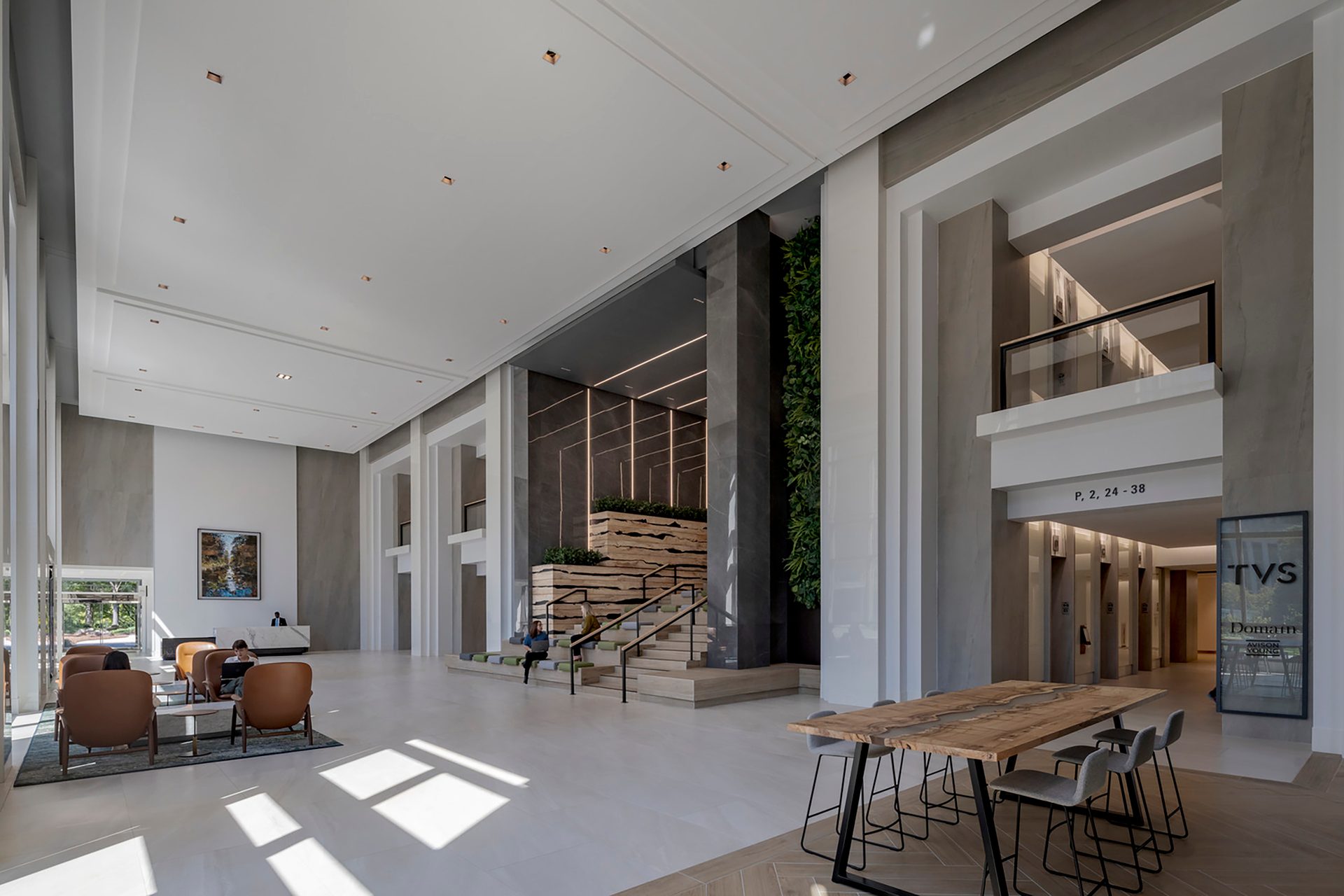How to Help Your Client Decide if Radiant Heating is Right for Them
Ceramic tile is one of the most effective types of floor coverings to use with radiant heating as it retains heat between system cycles
by Skip Daugherty, senior designer at REHAU
The Mulmur residence in Toronto, ON, features nearly 10,000 feet (3,048 m) of REHAU RAUPEX® O2 barrier pipe beneath the tile floor to maximize warmth throughout the spacious home. Photo courtesy of Profile Custom Homes.
There are several factors that influence human comfort, such as the temperature of surfaces around you, air temperature and even clothing. The mechanical systems of a house play an important role in creating a livable home. Helping clients pick a heating system, or a series of heating options for their home, starts by understanding their needs. Having a thorough understanding of all the options will help your client select the best choice for their home.
Radiant heating, sometimes called under-floor heating, offers gradual room-filling convection heat that is silent and energy efficient. When the surfaces of the home can be actively heated, less of a homeowner’s comfort depends on other factors. Radiant heating is a smart option if your client is looking to ensure the comfort, efficiency and architectural freedom of their home.
All radiant systems have the same basic functionality
A radiant system heats or cools an indoor space by circulating a fluid, generally a water/glycol mixture, through a network of PEX pipe. In a radiant heating application, a heat source (condensing boiler, geothermal heat pump, etc.) warms a fluid. A pump circulates the fluid through the heat source and out to the area you are heating. The warm fluid branches into many, smaller closed-loop circuits of PEX. The circuits of pipe are evenly spaced, hidden behind a finished surface. The network of PEX gently warms the room. As the fluid cools, it passes through the heat source again. A radiant cooling system uses a chilled water source and circulates cool fluid instead of warm fluid.
By emitting heat through a network of PEX pipes hidden in floors, ceilings or walls, radiant heating provides the opportunity to adjust the actual surface temperatures of the objects in a space.
Installation types
There are two primary ways to install a radiant heating system with PEX: wet systems and dry systems. The majority of radiant heating and cooling systems consist of PEX pipe embedded in concrete. These are considered wet installation methods. The two types of wet installation methods include:
- Structural concrete slabs: Used in projects where concrete is poured over and around the pipe, which is fastened to a structural wire mesh and/or rebar. This is the typical radiant heating and cooling installation. The radiant panel is embedded in the structural slab, eliminating additional installation steps.
- Overpours: Used in projects where a thin layer of gypsum concrete is poured over a structural slab or subfloor. Low-mass pours often speed up system response time. The second type of radiant heating system is installed via dry installation methods. There is no need to pour concrete with these radiant systems, as they consist of aluminum and wood panels with prefabricated grooves for the pipe.
- Above-floor panel systems: Used in projects on top of structural floors. These low-profile products allow you to install radiant in a space without pouring concrete. These systems are lightweight and still allow you to use a variety of floor coverings. Heat transfer panels fit tight construction schedules and install quickly using typical framing tools. Low-mass systems can warm up and cool down quickly, making for a faster response time to thermostat temperature changes.

Peter Gasperini, owner of Northeast Radiant, a Pleasantville, NY-based company that specializes in radiant heating and plumbing systems, equipped his home with a REHAU radiant heating and snow and ice melting system. For the living areas and bedrooms, the Gasperinis chose a RAUPANEL™ radiant system, consisting of 3,000 feet (914 m) of 3/8 inch crosslinked polyethylene (PEXa) pipe laid in aluminum panels installed between the subfloor and flooring material. Photo ©REHAU
Comfort
Radiant heating provides room-by-room control, allowing the homeowner to decide which spaces need more heat. Typical floor temperatures range between 80 and 85 degrees. A chilly home office or basement can be alleviated by installing a radiant heating system, allowing a homeowner to control the temperature of individual rooms and create many different comfort zones.
Efficiency
Radiant heating gives more control of a home’s comfort, but it also gives more control over the home’s energy usage. Low supply water operating temperatures and large surface areas are key for reducing fuel consumption. In best cases, the water for a radiant system is warmed by energy-efficient, condensing boilers or renewable energy sources.
With room-by-room controls, radiant heating ensures that energy is not wasted on unoccupied spaces. Additionally, radiant heating allows the homeowner to lower the indoor temperature set point while maintaining a comfortable level of warmth in the home. Radiant systems work best in “set it and forget it mode,” where a thermostat can be set a few degrees cooler than would be comfortable with forced-air-only systems, ultimately saving the homeowner up to 30% on heating bills.
While initial installation costs are sometimes higher, the operating costs of a radiant system are generally lower over the life of a home. Paired with the benefits of zone-ability, comfort and reduced operating noise, radiant prevails for occupant comfort.
Architectural freedom
No wires and less ductwork to detract from the comfortable design you envision. Radiant heating keeps spaces clean and free of clutter since the system is hidden within floors, walls or ceilings, giving you more design possibilities with a client’s floor space.
Radiant heating can be installed under a surprisingly large number of floor coverings. Properties that make a floor covering suitable for radiant heating systems tend to center around the thickness of the flooring, the flooring's thermal conductive nature, its tendency to expand and contract, and whether it is prone to water and heat damage.
An excellent conductor of heat due to its low R-values, ceramic tile is one of the most effective types of floor coverings to use with radiant heating as it retains heat between system cycles. As a mineral-based floor covering, tile is an excellent thermal conductor. On top of that, ceramic tile is inexpensive, available, easy to install and waterproof.
Radiant heating systems can even be retrofitted into an existing home, heating the floors from below, in the joist space. In fact, there is no need to change anything with existing floor coverings, because plates are placed between the joists from a crawl space or from the ceiling of the floor below.
Maintenance
In addition to operational costs, clients will want to know about maintenance of radiant heating systems. All mechanical systems require maintenance, but radiant systems are a closed loop, so the system fluid does not pick up dust or debris from the room. In contrast, a forced-air system may end up with an air filter full of dust or pet fur, which can reduce efficiency.
And most homeowners will see a return on radiant heating installations, boosting the resale value of a home. In a study of four million homes sold in 2016 and 2017, Zillow found radiant heating to be among the most valuable upgrades homeowners could make to increase home value. “Radiant heating” was one of the most popular keywords in a home listing, and the presence of heated floors corresponded with a 24% higher sale price.
Health benefits
Another benefit of radiant heating is that allergens and dust aren’t being blown around — a disadvantage of forced-air heating systems. Forced-air systems also suck the humidity out of a space, leaving the air (and skin) feeling dried out. Radiant heating systems don’t have these issues. Rather, radiant heating can help create an indoor environment lower in air allergens and can help you balance your space with a comfortable humidity.
Clinging radiators, vents turning on and off — sounds like these aren’t an issue for radiant heating systems, which are virtually silent.
Winter is upon us, and it is important to help your clients prepare for the season’s quickly fluctuating temperatures. Radiant heating is a good option to provide immediate, comfortable heat inside no matter the weather outside.

